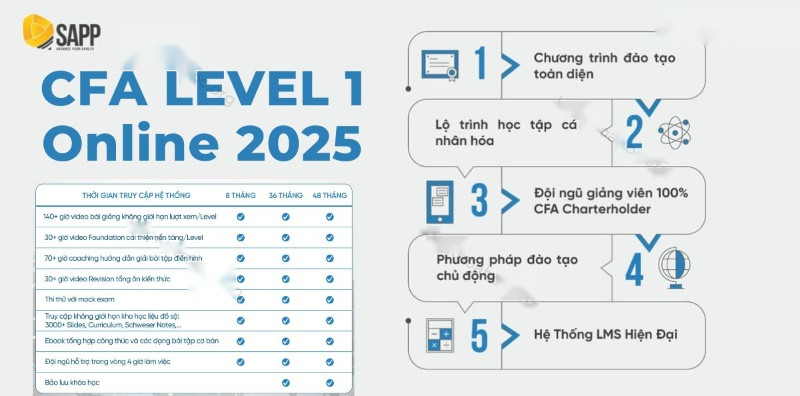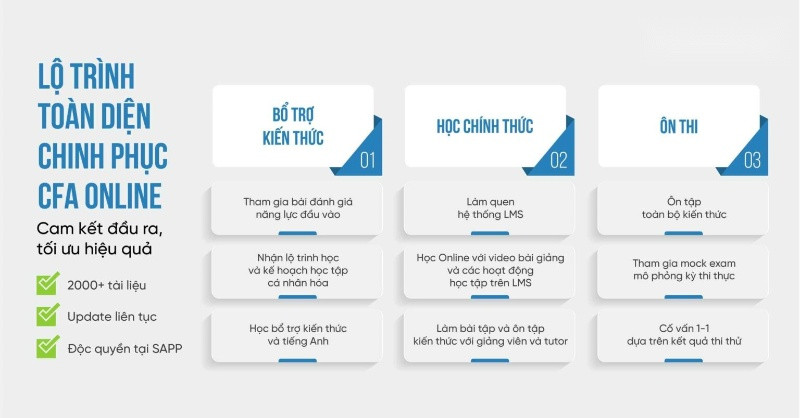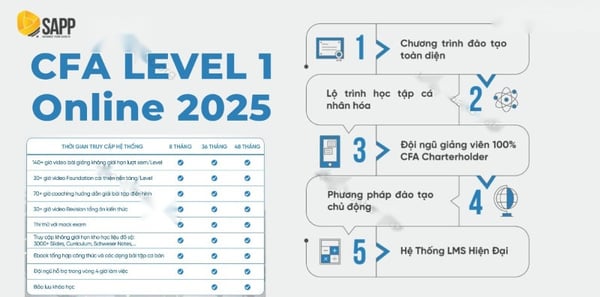Share Chương Trình Đào Tạo CFA Level 1 Online 2025 Cùng Sapp
Share Chương Trình Đào Tạo CFA Level 1 Online 2025 Cùng Sapp được thiết kế toàn diện, với Lộ trình học tập cá nhân hóa, 100% đội ngũ giảng viên chuyên gia cung cấp kiến thức cho học viên, nhằm giảm thiểu tối đa rào cản học tập, giúp người học chủ động, linh hoạt tiếp cận kiến thức chuẩn hóa.

Tại Sao Nên Tham Gia Chương Trình Đào Tạo CFA Online 2025 Tại Sapp
♦ Lộ trình học tập CFA Online SAPP được xây dựng toàn diện và cá nhân hóa, thiết kế tỉ mỉ, đảm bảo vừa nâng cao kiến thức nền tảng vừa phát triển kỹ năng thực tiễn.
♦ Kho học liệu của SAPP Academy được thiết kế để cung cấp một nền tảng học tập toàn diện và hiệu quả, giúp học viên chuẩn bị tốt nhất cho các kỳ thi chứng chỉ tài chính quốc tế.
♦ Tự hào sở hữu đội ngũ giảng viên 100% là CFA Charterholder, những chuyên gia hàng đầu trong lĩnh vực tài chính với hơn 15 năm kinh nghiệm thực tiễn.

Bạn Sẽ Học Được Gì Từ Chương Trình Đào Tạo CFA Online 2025
☀ Khả năng giải thích và trình bày kiến thức về giá trị thời gian của tiền bạc, kỹ năng thu thập và phân tích dữ liệu, nền tảng về xác suất và thống kê, lý thuyết xác suất và các phân phối liên quan. Ngoài ra, việc ước lượng, kiểm định giả thuyết và hồi quy tuyến tính cũng được áp dụng trong quyết định tài chính.
☀ Cung cấp kiến thức về cả kinh tế vi mô và vĩ mô.
☀ Hiểu biết về quy trình và tiêu chuẩn trong báo cáo tài chính, nhấn mạnh vào việc phân tích từng loại báo cáo và ảnh hưởng của các phương pháp kế toán đến chúng.
☀ Trang bị cho người học nền tảng về quản trị doanh nghiệp, các phương pháp huy động vốn, kiểm soát chi phí vốn và lập kế hoạch ngân sách nhằm tối ưu hóa hiệu quả đầu tư.
☀ Cung cấp khả năng mô tả đặc điểm của đầu tư cổ phiếu, thị trường chứng khoán và chỉ số thị trường; phân tích ngành, doanh nghiệp và cổ phiếu; trình bày các mô hình định giá cổ phiếu cơ bản.
☀ Tổng quan về thị trường nợ và các khái niệm quan trọng liên quan đến tính toán và diễn giải giá trái phiếu, lợi suất và đo lường rủi ro; phân tích tín dụng và quy trình chứng khoán hóa.
☀ Khả năng phân tích các công cụ phái sinh, xây dựng nền tảng lý thuyết cho các công cụ và thị trường phái sinh, bao gồm hợp đồng kỳ hạn, tương lai, hoán đổi và quyền chọn.
☀ Cung cấp kiến thức về đầu tư thay thế như vốn cổ phần tư nhân và bất động sản, những lĩnh vực không thuộc đầu tư truyền thống, có độ phức tạp và rủi ro cao, thường do các nhà đầu tư giá trị ròng cao sở hữu.
☀ Giới thiệu các phương pháp đầu tư, quản lý lợi nhuận và rủi ro trong danh mục, và các hành vi trong tài chính đầu tư.
Lộ Trình Đào Tạo CFA Online 2025
Topic 1: Quantitative Methods
Learning module 1: Rates and Returns
Learning module 2: The Time Value of Money in Finance
Learning module 3: Statistical Measures of Asset Returns
Learning module 4: Probability Trees and Conditional Expectations
Learning module 5: Portfolio Mathematics
Learning module 6: Simulation Methods
Learning module 7: Estimation and Inference
Learning module 8: Hypothesis Testing
Learning module 9: Parametric and Non-parametric Tests of Independence
Learning module 10: Simple Linear Regression
Learning module 11: Introduction to Big Data Techniques
Topic 2: Economics
Learning module 1: Firms and Market Structures
Prerequisite reading: Aggregate Output, Prices, and Economic Growth
Learning Module 2: Understanding Business Cycles
Learning module 3: Fiscal Policy
Learning module 4: Monetary Policy
Learning module 5: Introduction to Geopolitics
Learning module 6: International Trade
Learning module 7: Capital Flows and the FX Market
Learning module 8: Exchange Rate Calculations
Topic 3: Financial Statement Analysis
Learning module 1: Introduction to Financial Statement Analysis
Prerequisite reading: Financial Reporting Standards
Learning module 2: Analyzing Income Statements
Learning module 3: Analyzing Balance Sheets
Learning module 4: Analyzing Statements of Cash Flows I
Learning module 5: Analyzing Statements of Cash Flows II
Learning module 6: Analysis of Inventories
Learning module 7: Analysis of Long-Term Assets
Learning module 8: Topics in Long-Term Liabilities and Equity
Learning module 9: Analysis of Income Taxes
Learning module 10: Financial Reporting Quality
Learning module 11: Financial Analysis Techniques
Prerequisite reading: Applications of Financial Statement Analysis
Learning module 12: Introduction to Financial Statement Modeling
Topic 4: Corporate Issuers
Learning Module 1: Organizational Forms, Corporate Issuer Features, and Ownership
Learning Module 2: Investor and Other Stakeholders
Learning Module 3: Corporate Governance: Conflicts, Mechanisms, Risks and Benefit
Learning Module 4: Working Capital and Liquidity
Learning Module 5: Capital Investment and Capital Allocation
Learning Module 6: Capital Structure
Learning Module 7: Business Models
Topic 5: Equity
Learning module 1: Market Organization and Structure
Learning module 2: Security Market Indexes
Learning module 3: Market Efficiency
Learning module 4: Overview of Equity Securities
Learning module 5: Company Analysis: Past and Present
Learning module 6: Industry and Competitive Analysis
Learning module 7: Company Analysis: Forecasting
Learning module 8: Equity Valuation: Concepts and Basic Tools
Topic 6: Fixed Income
Learning Module 1: Fixed-income Instrument Features
Learning Module 2: Fixed-income Cash Flows and Types
Learning Module 3: Fixed-income Issuance and Trading
Learning Module 4: Fixed-income Markets for Corporate Issuers
Learning Module 5: Fixed-income Markets for Government Issuers
Learning Module 6: Fixed-income Bond Valuation: Prices and Yields
Learning Module 7: Yield and Yield Spread Measures for Fixed-rate Bonds
Learning Module 8: Yield and Yield Spread Measures for Floating-rate Instruments
Learning Module 9: The Term Structure of Interest Rate: Spot, Par and Forward Curves
Learning Module 10: Interest Rate Risk and Return
Learning Module 11: Yield-based Bond Duration Measures and Properties
Learning Module 12: Yield-based Bond Convexity and Porfolio Properties
Learning Module 13: Curve-based and Empirical Fixed-income Risk Measures
Learning Module 14: Credit Risk
Learning Module 15: Credit Analysis for Goverment Issuers
Learning Module 16: Credit Analysis for Corporate Issuers
Learning Module 17: Fixed-income Securitization
Learning Module 18: Asset-backed security (ABS) Instrument and Market Features
Learning Module 19: Mortgage-backed security (MBS) Instrument and Market
Topic 7: Derivatives
Learning Module 1: Derivative markets and instruments
Learning Module 2: Forward commitment and contingent claim features and instruments
Learning Module 3: Derivative benefits, risks and issuer and investor uses
Learning Module 4: Arbitrage, replication and the cost of carry in pricing derivatives
Learning Module 5: Pricing and valuation of forward contracts and for an underlying with varying maturities
Learning Module 6: Pricing and valuation of futures contracts
Learning Module 7: Pricing and valuation of interest rates and other swaps
Learning Module 8: Pricing and valuation of options
Learning Module 9: Option replication using put-call parity
Learning Module 10: Valuing a derivative using a one-period binomial model
Topic 8: Alternative Investments
Learning Module 1: Alternative Investment Features, Methods And Structures
Learning Module 2: Alternative Investment Performance And Returns
Learning Module 3: Investments In Private Capital: Equity And Debt
Learning Module 4: Real Estate And Infrastructure
Learning Module 5: Natural Resources
Learning Module 6: Hedge Funds
Learning Module 7: Introduction to Digital assets
Topic 9: Portfolio Management
Learning Module 1: Portfolio Risk and Return – Part I
Learning Module 2: Portfolio Risk and Return – Part II
Learning Module 3: Portfolio Management: An Overview
Learning Module 4: Basics of Portfolio Planning and Construction
Learning Module 5: The Behavioral Biases of Individuals
Learning Module 6: Introduction to Risk Management
Topic 10: Ethical And Professional Standards
Learning Module 1: Ethics and Trust in the Investment Profession
Learning Module 2: Code of Ethics and Standards of Professional Conduct
Learning Module 3: Guidance for Standards I–VII
Learning Module 4: Introduction to the Global Investment Performance Standards (GIPS)
Learning Module 5: Ethics Application



































